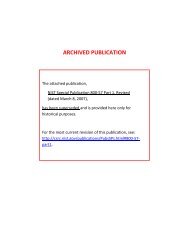NISTIR 7298 Revision 1, Glossary of Key Information Security Terms
NISTIR 7298 Revision 1, Glossary of Key Information Security Terms
NISTIR 7298 Revision 1, Glossary of Key Information Security Terms
Create successful ePaper yourself
Turn your PDF publications into a flip-book with our unique Google optimized e-Paper software.
NIST IR <strong>7298</strong> <strong>Revision</strong> 1, <strong>Glossary</strong> <strong>of</strong> <strong>Key</strong> <strong>Information</strong> <strong>Security</strong> <strong>Terms</strong><br />
Certificate Management –<br />
Certificate Management Authority –<br />
(CMA)<br />
Certificate Policy (CP) –<br />
A digitally signed representation <strong>of</strong> information that 1) identifies<br />
the authority issuing it, 2) identifies the subscriber, 3) identifies its<br />
valid operational period (date issued / expiration date). In the<br />
information assurance (IA) community, certificate usually implies<br />
public key certificate and can have the following types:<br />
cross certificate – a certificate issued from a CA that signs the<br />
public key <strong>of</strong> another CA not within its trust hierarchy that<br />
establishes a trust relationship between the two CAs.<br />
encryption certificate – a certificate containing a public key that can<br />
encrypt or decrypt electronic messages, files, documents, or data<br />
transmissions, or establish or exchange a session key for these same<br />
purposes. <strong>Key</strong> management sometimes refers to the process <strong>of</strong><br />
storing, protecting, and escrowing the private component <strong>of</strong> the key<br />
pair associated with the encryption certificate.<br />
identity certificate – a certificate that provides authentication <strong>of</strong> the<br />
identity claimed. Within the National <strong>Security</strong> Systems (NSS) PKI,<br />
identity certificates may be used only for authentication or may be<br />
used for both authentication and digital signatures.<br />
SOURCE: CNSSI-4009<br />
A set <strong>of</strong> data that uniquely identifies a key pair and an owner that is<br />
authorized to use the key pair. The certificate contains the owner’s<br />
public key and possibly other information, and is digitally signed by<br />
a Certification Authority (i.e., a trusted party), thereby binding the<br />
public key to the owner.<br />
SOURCE: FIPS 186<br />
Process whereby certificates (as defined above) are generated, stored,<br />
protected, transferred, loaded, used, and destroyed.<br />
SOURCE: CNSSI-4009<br />
A Certification Authority (CA) or a Registration Authority (RA).<br />
SOURCE: SP 800-32<br />
A specialized form <strong>of</strong> administrative policy tuned to electronic<br />
transactions performed during certificate management. A Certificate<br />
Policy addresses all aspects associated with the generation,<br />
production, distribution, accounting, compromise recovery, and<br />
administration <strong>of</strong> digital certificates. Indirectly, a certificate policy<br />
can also govern the transactions conducted using a communications<br />
system protected by a certificate-based security system. By<br />
controlling critical certificate extensions, such policies and associated<br />
enforcement technology can support provision <strong>of</strong> the security<br />
services required by particular applications.<br />
SOURCE: CNSSI-4009; SP 800-32<br />
Pg 26

















